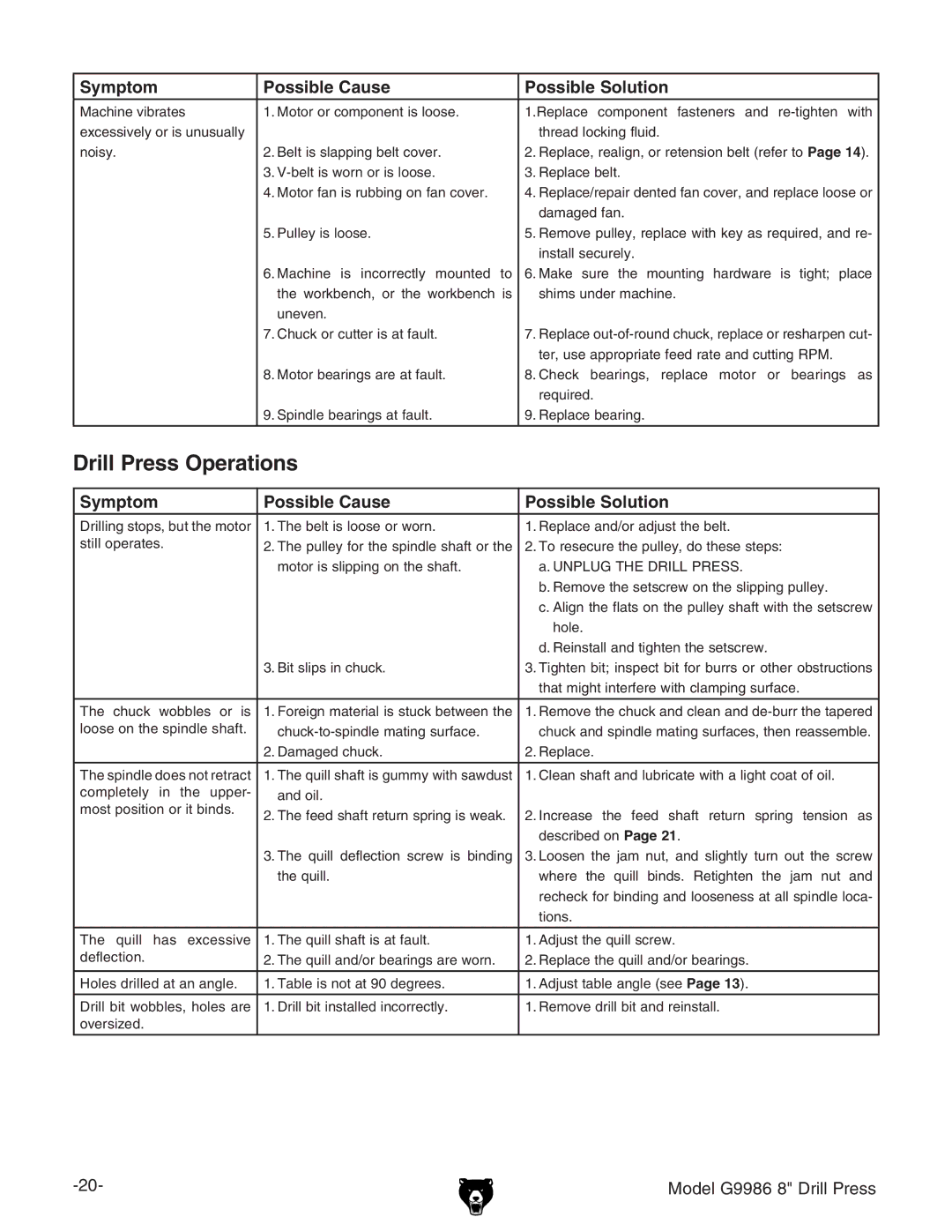Symptom | Possible Cause | Possible Solution |
Machine vibrates | 1. Motor or component is loose. | 1.Replace component fasteners and |
excessively or is unusually |
| thread locking fluid. |
noisy. | 2. Belt is slapping belt cover. | 2. Replace, realign, or retension belt (refer to Page 14). |
| 3. | 3. Replace belt. |
| 4. Motor fan is rubbing on fan cover. | 4. Replace/repair dented fan cover, and replace loose or |
|
| damaged fan. |
| 5. Pulley is loose. | 5. Remove pulley, replace with key as required, and re- |
|
| install securely. |
| 6. Machine is incorrectly mounted to | 6. Make sure the mounting hardware is tight; place |
| the workbench, or the workbench is | shims under machine. |
| uneven. |
|
| 7. Chuck or cutter is at fault. | 7. Replace |
|
| ter, use appropriate feed rate and cutting RPM. |
| 8. Motor bearings are at fault. | 8. Check bearings, replace motor or bearings as |
|
| required. |
| 9. Spindle bearings at fault. | 9. Replace bearing. |
|
|
|
Drill Press Operations
Symptom | Possible Cause | Possible Solution |
Drilling stops, but the motor | 1. The belt is loose or worn. | 1. Replace and/or adjust the belt. |
still operates. | 2. The pulley for the spindle shaft or the | 2. To resecure the pulley, do these steps: |
| motor is slipping on the shaft. | a. UNPLUG THE DRILL PRESS. |
|
| b. Remove the setscrew on the slipping pulley. |
|
| c. Align the flats on the pulley shaft with the setscrew |
|
| hole. |
|
| d. Reinstall and tighten the setscrew. |
| 3. Bit slips in chuck. | 3. Tighten bit; inspect bit for burrs or other obstructions |
|
| that might interfere with clamping surface. |
|
|
|
The chuck wobbles or is | 1. Foreign material is stuck between the | 1. Remove the chuck and clean and |
loose on the spindle shaft. | chuck and spindle mating surfaces, then reassemble. | |
| 2. Damaged chuck. | 2. Replace. |
|
|
|
The spindle does not retract | 1. The quill shaft is gummy with sawdust | 1. Clean shaft and lubricate with a light coat of oil. |
completely in the upper- | and oil. |
|
most position or it binds. | 2. The feed shaft return spring is weak. | 2. Increase the feed shaft return spring tension as |
| ||
|
| described on Page 21. |
| 3. The quill deflection screw is binding | 3. Loosen the jam nut, and slightly turn out the screw |
| the quill. | where the quill binds. Retighten the jam nut and |
|
| recheck for binding and looseness at all spindle loca- |
|
| tions. |
|
|
|
The quill has excessive | 1. The quill shaft is at fault. | 1. Adjust the quill screw. |
deflection. | 2. The quill and/or bearings are worn. | 2. Replace the quill and/or bearings. |
|
|
|
Holes drilled at an angle. | 1. Table is not at 90 degrees. | 1. Adjust table angle (see Page 13). |
|
|
|
Drill bit wobbles, holes are | 1. Drill bit installed incorrectly. | 1. Remove drill bit and reinstall. |
oversized. |
|
|
|
|
|
Model G9986 8" Drill Press |
